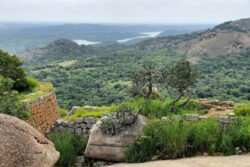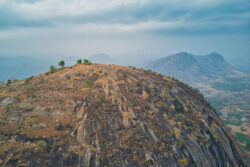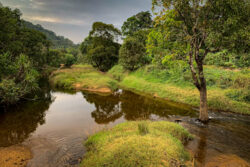The Chelavara river originates as a spring in the hills of Kabbe, in Kodagu. As it flows down the steep gradient, it picks up momentum and tiny feeder streams add to the volume, making it a fast-flowing river in the monsoons.

Eventually, the river flows over a large rock and drops over 150 feet into a deep pool below, before continuing its journey downstream. This waterfall, known as the Chelavara Falls, is a popular tourist destination.

The turn-off to Chelavara Falls from a small town called Cheyendane leads to a picturesque drive into a valley. With a steep drop-off on the left leading down to the Chelavara river, this road offers excellent birding and photography opportunities. Thanks to the gradient, one can photograph birds at eye level as they feed in the tree tops. The plantations below the road are lined with Erythrina trees which are used as shade for coffee and support for pepper vines. When the Erythrina trees are flowering, many species of birds come to feed on the flowers and the nectar. Golden-fronted Leafbirds, Square-tailed Bulbuls, Malabar and Plum-headed Parakeets, Vernal Hanging Parrots, White-headed and Chestnut-tailed Starlings, Golden Orioles, Nilgiri Flowerpeckers, Asian Fairy Bluebirds and barbets are some of the many species that visit these flowering trees.

A Crimson-backed Sunbird feeds on nectar at the parking lot.

A Square-tailed Bulbul photographed from the road to Kabbe.
Further on, the concrete road takes a sharp bend to the right and a sign marks the entrance to Chelavara Falls. The narrow mud path through a private coffee plantation is uneven and can be slippery during the rains. Entry onto the wet rocks below the waterfall is restricted.
The road continues past plantations and streams up into the hills, going past the excellent Kabbe Holidays homestay, and finally comes to an end just below Kabbe peak. Adjacent to a small car park is the Forest Department check-post, where the guards check for disposable plastic items and record visitor details. A few hundred meters ahead is a small pond to the left of the path, next to which a track goes up the hill. The mist-covered, grassy hillside looks like a scene out of Switzerland in the spring, with a few cattle grazing on the lush, green grass.

Going up the path, one gets to see a dense shola forest on the left, which is home to a variety of birds including the shy White-bellied Blue Flycatcher, and during certain times of the year, the elusive Nilgiri Woodpigeon. In the treetops, the White-bellied Treepie and Square-tailed Bulbul can be found feeding on a wide variety of wild fruits. One can hear the leaves on the ground crackling under the fruiting trees, as the birds drop ripened fruit from the canopy.

The deep booming call of the Mountain Imperial Pigeon travels far, and the rapid fluttering of wings signal the flight of these large birds.
The viewpoint is a 20 minute hike up from the parking spot and views from there are fantastic – a landscape photographer’s dream come true. The top of the hill is at an altitude of 1300 meters and the steep drop-off towards Kerala goes down to 200 meters, which translates to a drop of more than a kilometre.

Looking towards the west, one can see the Malabar coast on a clear day, a distance of 60 kilometres as the crow flies. To the northwest, the steep and precipitous Kabbe peak can be seen with the taller Thadiyandamol peak behind it.

A view of Kabbe from the Chomakundh peak.

Steep slopes of the Kabbe peak.
Kabbe peak has an altitude of 1420 meters, which is about 300 meters short of the Thadiyandamol peak, the tallest point in Kodagu. To the south-east is the spectacular Chomakundh peak, which is at an altitude of 1600 meters and is covered with dense shola forests.

Chomakundh peak
Hiking up Kabbe peak or going all the way to Chomakundh peak will need prior permission from the forest department, without which visitors are only allowed up to the viewpoint.
Kabbe really comes alive during the rains: tiny streams become little waterfalls and the sholas are shrouded in clouds.


A tiny waterfall with impatiens growing beside it.

Impatiens germinate, grow, mature, flower and fruit happily during the lush monsoon season. They disperse their seeds and die by the end of the monsoon season, and when the monsoon begins, the seeds germinate and the cycle repeats.

A Wayanad Shieldtail makes its way across the path after a heavy downpour.

In summer, the streams above the Chelavara Falls are magnets for many butterfly species like this gorgeous Malabar Banded Peacock.
Kabbe, with its diverse habitats and stunning views, has something to offer every visitor.





Instagram
junglelodgesjlr